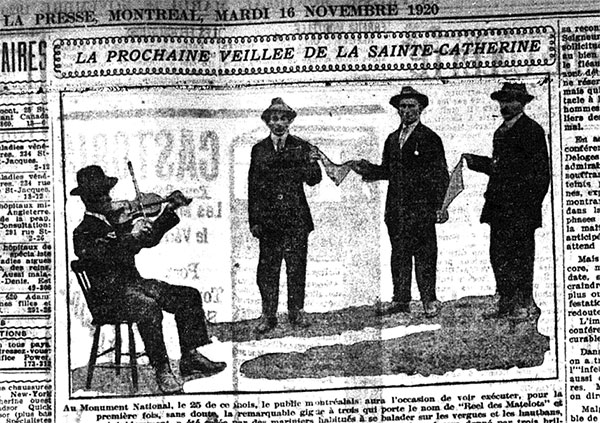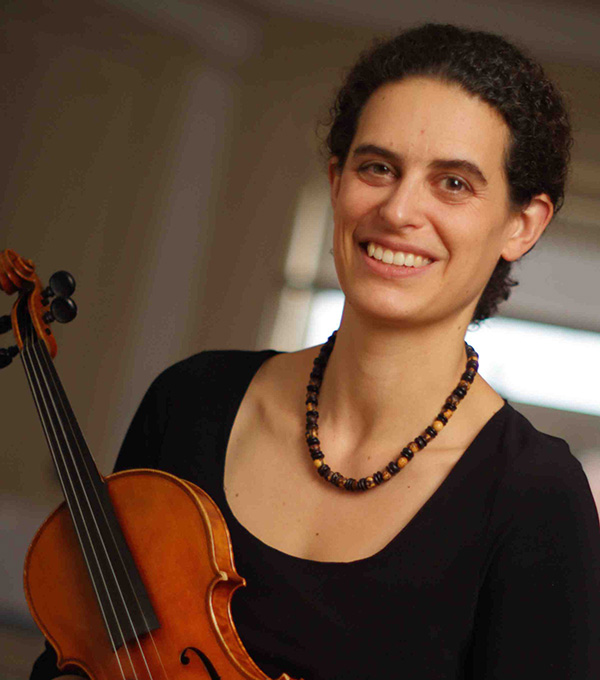Recent Schulich School of Music graduate Laura Risk (Ph.D., Musicology) applied her experience as a professional fiddler to her doctoral research on traditional music in Quebec. Risk grew up playing traditional Scottish fiddle music. Since moving to Montreal, she has also immersed herself in the traditional music of Quebec.
It is commonplace nowadays to say that traditions are “invented”: that nationalists, politicians, folklorists, writers, musicians, dancers, and others have at times selected, fixed, and linked choice elements of the flux of daily life to project an image of long- range stability. My dissertation investigates the mechanics of the invention of traditional instrumental music in Québec: where did this repertoire come from, how did it circulate, what were its political and social associations, and how did those shift over time?
I describe an historical moment when the genre of “folklore” as a musical embodiment of French-Canadian identity came into the public consciousness in Montreal and elsewhere in Quebec. I then use case studies to examine the evolution of traditional music in Quebec over the course of the twentieth century.
Veillées
A veillée is an informal family or community gathering that typically includes songs, stories, dance, and instrumental music. Since the early twentieth century, a veillée has also meant an idealized performance of such a gathering. These early staged veillées shaped cultural understandings of traditional music in Quebec and laid the foundations for a century of mediated representations of traditional music and dance. In my dissertation, I use contemporary newspaper and magazine articles to document the first wave of staged veillées: over two dozen performances between 1919 to 1922.

I argue that the first generation of folklorists in Quebec used staged veillées to define the genre of folklore as the musical embodiment of French-Canadian identity. This genre encompassed not only the language-based arts of song and storytelling but also fiddle tunes, group social dancing, and step-dancing, and was grounded in the nationalist literary movements of the late nineteenth and early twentieth centuries.
Later in my dissertation, I return to staged veillées with a close look at the popular television show Soirée canadienne (1960–1983). Soirée canadienne showcased folk singers, dancers, and instrumental musicians from across the province, though in a highly regulated format. I describe the program’s role in shaping the content, presentation, and reception of traditional music in Quebec, and argue that the Soirée canadienne team used the show to provide a space for aural transmission in an increasingly mediated world. I also use Soirée canadienne to offers a preliminary theorization of the relationship between traditional music and notions of kitsch and authenticity.
Variants
Earlier scholars of folk and traditional music often used melodic and rhythmic variants to explore the boundaries of geographically defined genres, and to propose patterns of transmission between those genres. In my dissertation, I use variants to identify small-scale networks of musicians, to outline regional playing styles in the early twentieth century, and to explore how musicians create individualized tune settings from an idealized musical essence.
In the 1920s, fiddlers in Montreal often re-recorded the same tunes with alternate titles and created new tunes out of segments of existing repertoire. Under the auspices of the Single Interface for Music Score Searching and Analysis (SIMSSA) project, I worked with McGill programmer Lillio Mok to create a purpose-built computer program that could identify melodic variants. I used this program to compare 271 fiddle tunes recorded between 1923 and 1929. In my dissertation, I argue that high demand for recorded fiddle music in the 1920s spurred a wave of new composition.

Finally, I catalogue and analyze versions of the tune “Money Musk,” long considered the gold standard of fiddling in Quebec. “Money Musk” was composed by a Scottish fiddler in the 1770s but quickly acquired hit tune status on both sides of the North Atlantic. I use over forty recorded variants of “Money Musk” to demonstrate how region, nationality, instrumentation, and function may impact musicians’ interpretive decisions.

Laura Risk’s dissertation research was generously funded by a Vanier Canada Graduate Scholarship from the Social Sciences and Humanities Research Council of Canada (SSHRC), a Doctoral Award from Bibliothèque et Archives nationales du Québec, masters-level grants from SSHRC and the Fonds de recherche—Société et culture Québec, and ongoing support from McGill University.
Her dissertation is entitled "Veillées, Variants, and Violoneux: Generic Boundaries and Transnational Trajectories in the Traditional Instrumental Music of Quebec."



